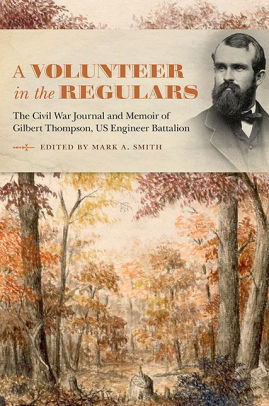Book Review: “A Volunteer in the Regulars: The Civil War Journal and Memoir of Gilbert Thompson, US Engineer Battalion”
 Published soldiers’ letters and diaries are nothing new to Civil War bookshelves. But editor Mark A. Smith’s latest addition to The University of Tennessee Press’ Voices of the Civil War series stands out among thousands of enlisted men’s published letters, diaries, and memoirs, not the least of which because this hefty volume contains both Gilbert Thompson’s wartime diary and his postwar memoirs. Smith also brings to light a valuable new source for studying the Army of the Potomac from the perspective of an engineer.
Published soldiers’ letters and diaries are nothing new to Civil War bookshelves. But editor Mark A. Smith’s latest addition to The University of Tennessee Press’ Voices of the Civil War series stands out among thousands of enlisted men’s published letters, diaries, and memoirs, not the least of which because this hefty volume contains both Gilbert Thompson’s wartime diary and his postwar memoirs. Smith also brings to light a valuable new source for studying the Army of the Potomac from the perspective of an engineer.
Massachusetts native Gilbert Thompson enlisted for three years in the topographical engineers (the “topogs” as Thompson routinely called them) in November 1861. From the beginning of his enlistment until he mustered out of the army in November 1864, Thompson recorded his impressions of events, covering topics as common as weather, camp boredom, marching, and battles and topics as obscure as military discipline, surveying and mapping, digging entrenchments, and constructing winter quarters. Due to his long service, which Thompson constantly counted down until his mustering out date, readers will find accounts of the Peninsula, Maryland, Fredericksburg, Chancellorsville, Gettysburg, Overland, and Petersburg campaigns from the eye of an engineer. Thompson’s journal runs through the regular tasks of an army engineer, explaining the construction of pontoon bridges spanning the Rappahannock, Potomac, and James rivers, the mapping of enemy entrenchments, and the design and construction of friendly earthworks.
Thompson’s prewar education enabled him to leave behind a valuable almost-daily diary of the Civil War as he experienced it. He grew up in Hopedale, Massachusetts, a utopian community. There, Thompson received schooling in literature, music, and art, all of which enhance his account, sprinkling it with a 19th-century reference list of books that he and other Civil War soldiers read on the front lines.
Additionally, Thompson’s artistic skills are showcased in this volume. Aside from writing, Thompson drew many sketches depicting his wartime experience. He often described something in detail in his diary and then sketched the scene. Editor Smith has faithfully reproduced Thompson’s valuable artistic additions to his journal and added sketches completed by Thompson’s engineer comrades at appropriate times throughout the manuscript. The inclusion of these images greatly enhances the book and makes it a valuable visual account of a common soldier in the Army of the Potomac.
Gilbert Thompson was aware of the value his diary would have for future readers. Anytime he filled up one journal, he noted it, sent it home for safekeeping, and began to write in a new one. Starting roughly fifteen years after the war, Thompson returned to his wartime writings and supplemented them with corrections, annotations, explanations, and an expansion of wartime thoughts that read like a memoir. It is rare to have a soldier’s diary personally annotated. Other times, we have a soldier’s memoir that is based on their personal diary but is not an exact copy of it. Smith ensures that readers receive an accurate reproduction of both Thompson’s wartime writings and postwar musings and seamlessly blends the two together while carefully noting where Thompson’s contemporary thoughts and postwar additions begin and end. The inclusion of Thompson’s wartime and postwar thoughts side-by-side allows readers to see how memories and perspectives change as time passes.
Though scans of Thompson’s journal have been reproduced online by the Library of Congress, Smith’s careful editorial work has made this valuable resource more widely and readily available (as long as one is willing to pay the $58 price). Editor Smith has added his own annotations to further supplement Thompson’s writings.
Regarding the the work of the United States Engineer Battalion at Yorktown in 1862, Thompson wrote, “The Engineers have no chance for brilliancy of attack like Cavalry or Infantry, but our work though hidden is equally important” (50). Thankfully, the work of Thompson and his comrades will further come to light in this latest publication by The University of Tennessee Press.
Mark A. Smith, ed., A Volunteer in the Regulars: The Civil War Journal and Memoir of Gilbert Thompson, US Engineer Battalion.
The University of Tennessee Press, 2020.
476 pages. Endnotes, bibliography, index.
Kevin:
Thanks for this post. The book is an excellent source for understanding the role of the US Engineer Battalion in the war. I do take minor issue with one statement by Thompson (who served in a different company than did my ancestor, who was in “C” and then “D”).
““The Engineers have no chance for brilliancy of attack like Cavalry or Infantry, but our work though hidden is equally important”
True but Company D, at least, was issued rifle-muskets and ordered into the front line on Day 2 at the Wilderness to help stem Longstreet’s attack. They got handed rifles again during the fighting at Spotsylvania. But, to be sure, most of their combat was with Virginia mud. 🙂
Thompson is such a good resource for so many AotP campaigns
I think you just sold the book (or at least convinced me to borrow it from the library sometime) with the promised details about the Central Virginia campaigns and battles. Always looking for new images and good primary sources for work research! Thank you.